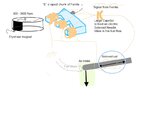thudpucker
Member level 2
- Joined
- Feb 7, 2007
- Messages
- 50
- Helped
- 0
- Reputation
- 0
- Reaction score
- 0
- Trophy points
- 1,286
- Location
- North Alabama
- Activity points
- 1,709
I've asked this in the past. I don't think I made myself clear though.
Here's a drawing of the whole thing as far as I know it will be at this time.
The questions are plethoral!
The purpose of this Idea is to make an electrically operated Needle valve. The problem with most little Gas engines is the Needle valve sticking.
My Needle valve is going to be power both ways.
1. I have that big piece of Ferrite.
I thought if I wound some wire around each leg of the "E" I'd get a "LUMP" off each of the legs as the Ign magnet passed by the ends of the Ferrite. That would charge a Cap. (I don't know what kind and how much of a Cap)
Is that wrong?
Any hints on how to go about that? Thin wire, Thick wire? 10 turns or 200 turns?
2. Now look down at that Blue Circle around my Needle valve Solenoid.
Can I wire that coil to make it go both in and out under power very very quickly?
The Working RPM is 3500 which would cycle the Needle Valve about 900/minute.
I'll have to vary the length of the Needle pulse to make it work at 800Rpm (Idle) and 3500 Rpm(full throttle). I'll work on that later unless someone has the answer right now. Thank you if you do.
The Big Small engine companies have used a Large capacitor to re-start after the initial start up and run. My idea is for a 5 Hp Recoil start engine.
I'm fairly certain somebody by now has an invention like I have in mind and is working which might have me re-inventing the wheel. But I don't know of anybody doing it.
It's chilly now and I can't go to my Barn and enjoy myself. But If I can get some questions asked, I'll start on whatever I can do in the house.
Here's a drawing of the whole thing as far as I know it will be at this time.
The questions are plethoral!
The purpose of this Idea is to make an electrically operated Needle valve. The problem with most little Gas engines is the Needle valve sticking.
My Needle valve is going to be power both ways.
1. I have that big piece of Ferrite.
I thought if I wound some wire around each leg of the "E" I'd get a "LUMP" off each of the legs as the Ign magnet passed by the ends of the Ferrite. That would charge a Cap. (I don't know what kind and how much of a Cap)
Is that wrong?
Any hints on how to go about that? Thin wire, Thick wire? 10 turns or 200 turns?
2. Now look down at that Blue Circle around my Needle valve Solenoid.
Can I wire that coil to make it go both in and out under power very very quickly?
The Working RPM is 3500 which would cycle the Needle Valve about 900/minute.
I'll have to vary the length of the Needle pulse to make it work at 800Rpm (Idle) and 3500 Rpm(full throttle). I'll work on that later unless someone has the answer right now. Thank you if you do.
The Big Small engine companies have used a Large capacitor to re-start after the initial start up and run. My idea is for a 5 Hp Recoil start engine.
I'm fairly certain somebody by now has an invention like I have in mind and is working which might have me re-inventing the wheel. But I don't know of anybody doing it.
It's chilly now and I can't go to my Barn and enjoy myself. But If I can get some questions asked, I'll start on whatever I can do in the house.
